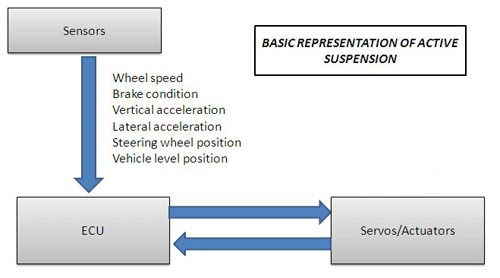Active Suspension Systems
- Basic Description
-
A vehicle's suspension system typically consists of springs and shock absorbers that help to isolate the vehicle chassis and occupants from sudden vertical displacements of the wheel assemblies during driving. A well-tuned suspension system is important for the comfort and safety of the vehicle occupants as well as the long-term durability of the vehicle's electronic and mechanical components.
The suspension systems in most vehicles on the road today are passive. The chassis of the vehicle is attached to the axles or wheel assemblies through coil springs or leaf springs that help to protect the chassis from sudden vertical forces applied to the wheels (e.g. due to bumpy roads, pot holes, etc...). The shock absorbers help to dissipate the energy applied to the springs and damp the oscillations that would normally occur when a brief excitation is applied to a mass-spring system.

Active suspension systems sense the forces being applied to the wheels and constantly adjust the mechanical connections between the chassis and wheel assemblies to keep the chassis level and/or optimally absorb the energy associated with the vertical motion of the wheels. Additionally, with the advent of increased computer control, various options of suspension travel and response can be adjusted by the driver while driving. Typical examples include a "Sport" mode that yields a more dynamic response.
Systems that are only able to adjust the viscous damping coefficient of the shock absorber and not the spring rate are generally referred to as "semi-active" suspension systems. A basic semi-active suspension uses an electrically controlled valve to adjust the flow of hydraulic fluid inside the shock absorber to change its dampening characteristics. A more recent innovation uses an electrically generated magnetic field to effectively change the viscosity of a shock absorber fluid that holds metallic particles.
Mercedes-Benz has developed a system that they call “Magic Body Control.” This fully active system not only monitors forces imposed upon the car’s suspension system, but also monitors the conditions of the road ahead. Two image sensors on the front of the car actively scan the road ahead and prepare the suspension ahead of time to compensate for sudden changes in the road surface height.
- Sensors
- Acceleration sensors, displacement sensors, steering wheel position
- Actuators
- Shock absorbers with electrically variable resistance and/or struts that can be extended or retracted based on electric signal input.
- Data Communications
- High-speed CAN bus data communication with electronic stability control module and engine control module.
- Manufacturers
- Bose, BWI Group, Eaton, Hitachi, LORD, Magneti Marelli, Mercedes-Benz, Porsche, Quanser, Tanabe,
Tenneco, ZF
- For More Information
- [1] Active Suspension, Wikipedia.
- [2] Magnetic Damper - Magnetorheological Damper, Formula 1 Dictionary website.
- [3] Evolution of Ride, Levant Power website.
- [4] Suspension Control, Infineon website.
- [5] Suspension III: Active Suspension Systems, Scott Memmer, Edmunds.com.
- [6] Acura Active Suspension, Acura website.
- [7] Bose Active Suspension, YouTube, May 24, 2007.
- [8] Electromagnetic Active Suspension System, YouTube, April 14, 2011.
- [9] Porsche 911 Active Stability Management (PASM) Nicely Explained, YouTube, Jun. 3, 2011.
- [10] Bose Active Suspension - Leaping Lexus,
YouTube, Apr. 11, 2012.
- [11] Mercedes-Benz Active Body Control -- Fully Active Suspension Technology, YouTube, May 14, 2013.
- [12] Mercedes Benz How Magic Body Control Works, YouTube, Sep. 13, 2013.
|

